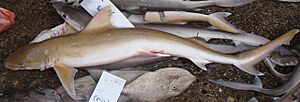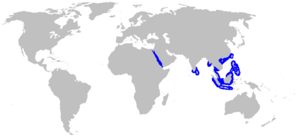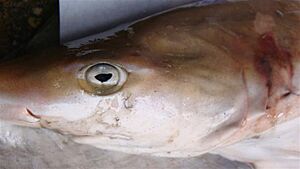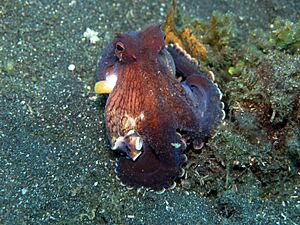Sicklefin weasel shark facts for kids
Quick facts for kids Sicklefin weasel shark |
|
|---|---|
 |
|
 |
|
| Conservation status | |
| Scientific classification | |
| Genus: |
Hemigaleus
|
| Species: |
microstoma
|
 |
|
| Range of the sicklefin weasel shark | |
| Synonyms | |
|
?Hemigaleus machlani Herre, 1929 |
|
The sicklefin weasel shark (Hemigaleus microstoma) is a type of ground shark. It belongs to the family called Hemigaleidae. This shark is not very common in the ocean.
You can find this shark in the waters near southern India, southern China, and parts of Southeast Asia. It lives in shallow areas, usually close to the sea floor. It can be found as deep as 170 meters (about 558 feet).
This shark has a short mouth and wide upper teeth. Its teeth have jagged edges only on the back side. Its fins are shaped like a sickle, which is a curved tool. The two dorsal fins (fins on its back) have clear white tips. The shark is light grey or bronze and sometimes has small white spots on its sides. It can grow up to 1.1 meters (about 3.6 feet) long.
The sicklefin weasel shark mainly eats cephalopods, like octopuses and squids. It gives birth to live young, which grow inside the mother. The baby sharks get food from their mother through a special connection. Females likely have two litters of pups each year. Each litter usually has two to four babies.
People catch this shark for its meat, fins (used in shark fin soup), and for fishmeal. Because there are not many of these sharks and they don't have many babies, they are easily affected by fishing. The International Union for Conservation of Nature (IUCN) says this shark is a vulnerable species. This means it is at risk of becoming endangered.
Contents
What is a Sicklefin Weasel Shark?
The sicklefin weasel shark is a slender shark that can grow up to 1.1 meters (about 3.6 feet) long. It has a fairly long, rounded snout. Its nostrils have small skin flaps in front of them. The shark has large, oval eyes with special eyelids called nictitating membranes. Behind its eyes are tiny holes called spiracles.
Its mouth is very short and wide. You can't see its teeth when its mouth is closed. There are medium-sized grooves at the corners of its mouth. It has 25 to 34 rows of teeth on its upper jaw and 37 to 43 rows on its lower jaw. The upper teeth are wide and angled, with a smooth front edge and a jagged back edge. The lower teeth are narrow, stand straight up, and have smooth edges. It has five short pairs of gill slits.
Shark's Fins and Skin
The fins of the sicklefin weasel shark are very curved, like a sickle. This is especially true for its dorsal fins, pelvic fins, and the lower part of its caudal fin (tail fin). Its pectoral fins (side fins) are narrow and pointed. The first dorsal fin is located about halfway between the pectoral and pelvic fins. The second dorsal fin is about two-thirds the height of the first one. It is placed slightly in front of the anal fin. The anal fin is smaller than the second dorsal fin.
The top part of its tail stem has a curved notch where the tail fin begins. The tail fin is not symmetrical. It has a well-developed lower part and a long upper part with a notch near the tip. The shark's skin is covered in tiny, overlapping scales called dermal denticles. Each scale has five ridges that lead to small teeth at the edge.
This shark is light grey or bronze on top. It often has small white spots on its sides and is pale underneath. The tips of its dorsal fins are white. This white tip is very easy to see on the second dorsal fin because the rest of that fin is mostly dark.
Where Do They Live?
The sicklefin weasel shark lives off the coasts of southern India and Sri Lanka. It is also found from southern China and Taiwan to Java and Borneo. It might also live around the Philippines and in the Red Sea. However, scientists need to study sharks from those areas more closely to be sure.
This shark does not seem to be very common naturally. It lives on the continental and insular shelves. These are the underwater edges of continents and islands. It can be found from close to shore down to at least 170 meters (about 558 feet) deep. It usually swims near the sea floor.
What Do They Eat?
The sicklefin weasel shark mostly eats cephalopods, such as octopuses and squids. Sometimes, it might also eat crustaceans (like crabs) and echinoderms (like sea stars). Its small mouth and short gill slits might help it suck in cephalopods. Its weak jaws and small teeth are good for eating soft-bodied prey.
Reproduction and Life Cycle
This shark is viviparous. This means the baby sharks grow inside the mother and are born live. The developing baby sharks get all their food from the mother through a special connection, similar to a placenta.
Female sharks likely have two litters of pups each year. This suggests that the time they carry their babies (gestation period) is less than six months. Each litter usually has between two and four pups, with an average of 3.3 babies. Newborn sharks are about 45 cm (about 18 inches) long.
Male sharks become ready to reproduce when they are about 74–75 cm (about 29–30 inches) long. Females become ready when they are about 75–78 cm (about 30–31 inches) long.
Human Interactions and Conservation
The sicklefin weasel shark is not dangerous to humans. People catch this shark in many places where it lives. They use different fishing methods like drifting and bottom gillnets, bottom trawls, and longlines.
The shark's meat is eaten, and its fins are used for shark fin soup. The leftover parts are made into fishmeal. However, because this shark is small, it doesn't have a high economic value.
The International Union for Conservation of Nature (IUCN) has listed the sicklefin weasel shark as vulnerable. This means it is at risk of becoming endangered. The IUCN notes that this shark is naturally uncommon and lives in areas where a lot of fishing happens. Also, compared to a similar shark called the Australian weasel shark, the sicklefin weasel shark does not have as many babies. This makes it less able to recover from fishing pressure.




